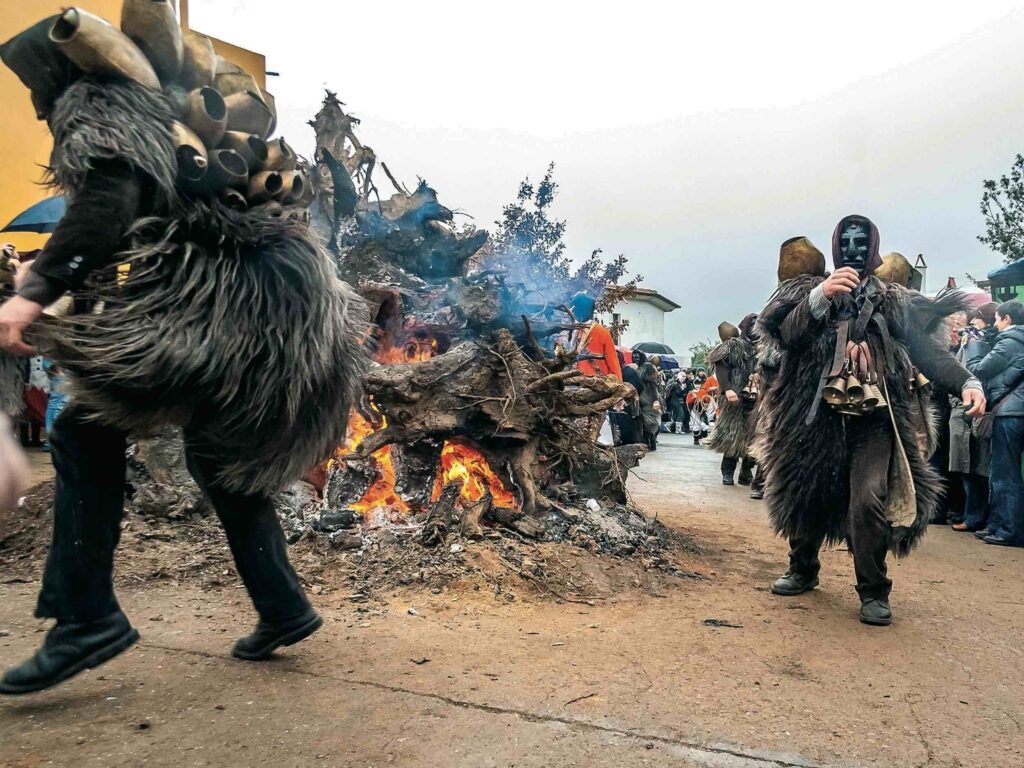Discover
For root tourists eager to immerse themselves in the ancient traditions of Sardinia, the Feast of Sant’Antonio Abate in Mamoiada offers an extraordinary experience, a journey into propitiatory rituals that captivates visitors from all over the world. Celebrated annually on January 16 and 17, this festival boasts a rich history and a deep connection to Sardinian culture, making it a must-see occasion for those seeking to rediscover their roots.
The festival is characterized by the presence of the “Mamuthones” and “Issohadores”, two masked figures representing the eternal opposition between black and white, death and rebirth, winter and spring.
- The festival begins on January 16, with the lighting of several bonfires in the various wards of the village. The main fire, lit in the square adjacent to St. Mary’s Church, is blessed by the priest thus highlighting pagan-Christian syncretism. In the evenings, in the various districts of the village, warmed by large fires, it is possible to taste typical local sweets accompanied by cannonau wine, classic “nostalgic products” that can make Sardinians who have emigrated breathe the air of home.
- On January 17, the festival reaches its climax. The “Mamuthones” and “Issohadores” make their first seasonal outing and visit the numerous bonfires, making three rounds in a circle at each one and renewing a propitiatory rite that has clear pagan origins and is an auspicious omen for the new agricultural year.
The origins of the festival
The festival has very ancient origins, and is believed to be linked to the worship of St. Anthony Abbot, the patron saint of animals. This rite has clear pagan origins and is linked to propitiatory rites; emblematic is the fact that through the sounding of the heavy cowbells the apotropaic function of driving away evil spirits is renewed.
The significance of the “Mamuthones” and “Issohadores”
The wide range of interpretations and conjectures that have been made about the procession of”Mamuthones”e “Issohadores”, constitutes a confirmation of how many, over the centuries, may have been the overlaps and its transformations of the first and original ritual core.
As for the Mamuthones e Issohadores a kind of syncretic “superimposition” has been implemented by the Church; thus, the feast of St. Anthony the Abbot has taken the place of an agrarian and pastoral propitiatory rite celebrated at a certain time of the year since the dawn of time.
The procession
The highlight of the festival is the procession of the “Mamuthones” and “Issohadores”. The likely apotropaic function of the sound of cowbells would relate back to ancient pagan rituals. Some anthropologists also interpret the “pace” of the “Mamuhtones”, heavy and seeming to vigorously trample the earth, as an exhortation to its productive awakening, its vegetative rebirth.
St. Anthony’s fires
St. Anthony’s fires are a time of celebration and purification. Fire participants gather to celebrate the end of winter and the beginning of spring. According to some elders, based on the direction the smoke from the fire took, one could tell whether the coming vintage was good or bad.
Days
16 January 24
17 January 24
From
Information/To know
Suitable for Everybody
Not wheelchair accessible
Location/The place
Address
Mamoiada, NU, Italia
How to get there
From Cagliari: Take SS131 northbound towards Oristano/Nuoro. From Oristano, take the SS131dir northeast towards Abbasanta/Macomer. From Macomer, take the SS389bis until you reach Mamoiada. From Oristano: Take SS131 north towards Abbasanta/Macomer. From Macomer, take the SS389bis until you reach Mamoiada. From Nuoro: Take the SS389bis until you reach Mamoiada. From Sassari: Take SS131 south toward Macomer/Nuoro. From Macomer, take the SS389bis until you reach Mamoiada.
